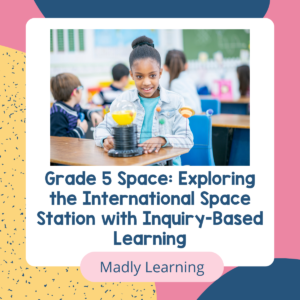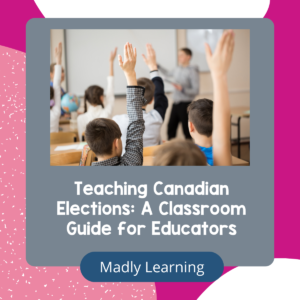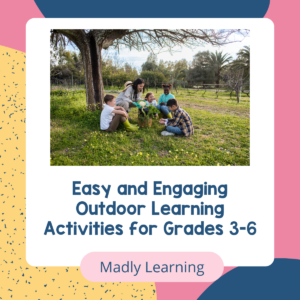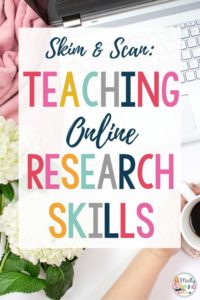
Research is one of the many tasks that students need to develop especially in today’s classroom with many inquiry projects, google and student led activities. Building student research skills is so important, and how to sort through too much research to find what they need, especially at their reading level is important.
By grade 4 students are finally ready to conduct some simple independent research. However, up until this point, they often have very little experience with doing this. This is one of the many tasks that needs to be explicitly taught.
Here are some tips to help your students research
Teach Them How to Skim and Scan
This skill will help them to determine if the text they are reading is a good fit for what they are looking for.
Skimming is a skill that involved students determining if the article is appropriate for what they need so that they don’t waste time reading a whole article that isn’t relevant. They will skim through the not fiction text features to find out if they need to read more or skip it.
This skill is best modeled for students by the teacher. Show them exactly what you want them to do and talk through your process to doing it. This can be repeated as necessary for students in guided sessions if they need additional support.
Scanning goes a little deeper to determine if what they read answers their question.
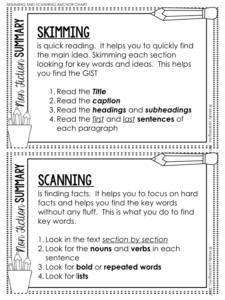
Once they have skimmed the text to determine that it is a good fit then they need to skim the sections of the text for the facts that answer their questions.
This is also easily modeled to students and this skill can be practiced. Use this anchor chart to help your students to follow along with key steps to help them skim and scan.
Skimming and Scanning are best taught in conjunction with summarizing. This skill is essential to help students to get the GIST of the article that they are reading to make sure that they pulling out key details. Summarizing and research are two skills that work very well together.
Get your skimming and scanning anchor chart here now.
Teach them How to Google
When I was in school I was taught how to use the Dewey Decimal System. Today as teachers it is important to teach them how to Google. (is it just me or do you hear the song “Teach them how to Dougie”)
I use the analogy with my students that they wouldn’t walk into a library and yell “How many years does a bear live?” and expect a book to fly off the shelf and hit them in the head. They would also not expect to see a book titled “How long a Bear Lives”
They would look simply for a book on bears.
Google works the same way.
They cannot ask Google a question and automatically get the information they are looking for. We need to teach them how to google. Here is a helpful page to use to help you learn how to google more effectively. 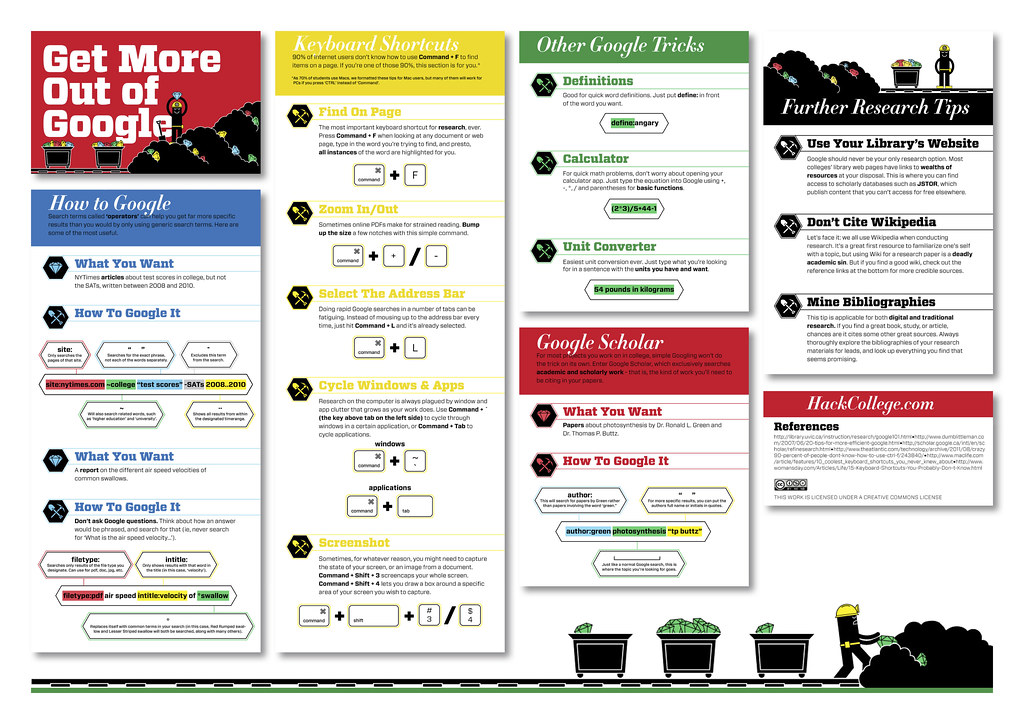
Learning how to Google is an important skill and this lesson can also touch on many cross-curricular expectations to make these lessons a good bang for your buck.
Assessing Websites
Once your students know how to skim and scan a text. They understand how to summarize a text and they can google effectively it is now important that they learn to sort the good, the bad, and the ugly (fake news)
To build student research skills there are things that students can look for to help them determine if a website is a good quality site that may be reliable.
Recognizable Brand
Sites like National Geographic, Scholastic, Encyclopedias, PBS, BBC and other news agencies are reliable and recognizable websites that are good places to start with student research.
Look at the URL
The URL gives many clues about how credible the source. Web sites that have the domain of .edu, and .gov are restricted and can only be used by certain institutions. These are generally considered reliable. If you are looking for information from specific regions the country domains such as .ca will let students know what country the website is from.
If you are looking for information from specific regions the country domains such as .ca will let students know what country the website is from. This will support student research when they are looking for content that is region specific.
Complicated URL sources with long unrecognizable names or blogs that are not simple .coms may be someone’s personal site and the information should be validated on multiple sites.
About Me and Bias
Web sites for student research should be clear about who the author is and who is producing the content. The author should be identified on the article themselves with a bio. If this is not present there should be a detailed about me page that identifies who wrote the information.
Authors should be experts on the subject area. Are they credible? Sometimes many popular research sites are not curated by experts and some are even student created websites. This is fine to use as a source but again the information should be validated in multiple places.
Another factor is bias. On the web, anyone can post their opinion. It is important for students to understand bias and how to recognize this in what they are reading.

Plagiarism
Whenever you talk about student research skills you inevitably talk about plagiarism. This is a great time to introduce your students to the concept of plagiarism. Today it is easy for students to simply just copy and paste what they read online into their notes then copy their notes into their own writing.
For me, this is a very simple concept. The original author owns the sentence. They have put the words together into a sentence. This is something that you cannot copy. However, at this age, they are not doing research into topics that may be unique or based on original research.
So this means that they can use the fact from the sentence but they cannot use the whole sentence.
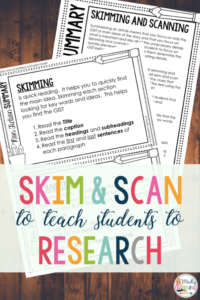
Again this is where the ability to teach your students how to do a GIST summary will help. Extracting the keywords from what they read. They assembling them into a summary is a very specific strategy that is similar to making research notes. They have to focus on the key ideas and ignore the fluff to write a summary. This is the same skill that students use when extracting information for researching too.
More information about the GIST strategy with summarizing can be found here.
Don’t forget to grab the Skim and Scan Anchor chart page that goes with this blog post.
Researching by using the web, is an important skill for student to master
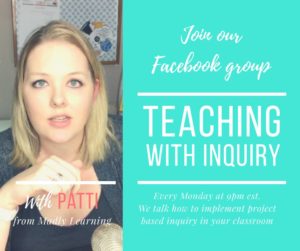
Did you know that this post originally started off as a Facebook Live Video? This and many other things are talked about every week in my Teaching With Inquiry Facebook group. If you aren’t already a member click here to join us and learn more about how to start using inquiry in your classroom.


